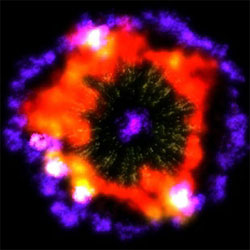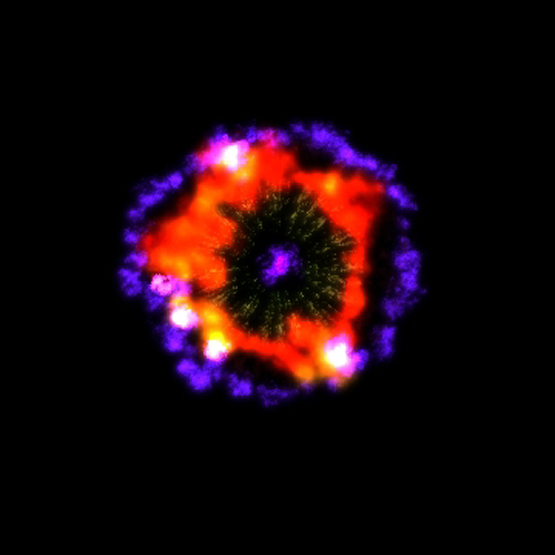Supernova Starting Gun: Neutrinos
The next time a star explodes in the Milky Way, researchers will be looking for faint ripples in space-time known as gravitational waves, which have never been seen directly. A paper published in the 17 July Physical Review Letters demonstrates a way to use the detection of neutrinos emitted by the supernova to identify the moment when the dying star would have begun emitting gravitational waves. Knowing the starting time will help researchers pick the waves out of a noisy background. The team used models of supernova emission and of neutrino detectors to predict the timing of the waves to within 10 milliseconds.
Before a dying star explodes, nuclear reactions generate neutrinos that carry away an estimated 99 percent of the supernova’s total radiated energy. Neutrinos barely interact with matter, so most of them fly right through the star’s layers and reach Earth before any other signs of the event. A supernova is expected in our galaxy about three times per century. In 1987, detectors picked up 24 neutrinos from a star exploding in the nearby Large Magellanic Cloud, 168,000 light-years away.
Since then, more advanced neutrino detectors have come online, as well as the first generation of laser-based gravitational wave detectors, such as LIGO and VIRGO. When the innermost core of a collapsing star reaches nuclear density–the neutron star stage–the outer core rebounds from the hard packed surface in what is called a bounce. This event should generate gravitational waves that could be detectable. The exact gravitational wave signature from a supernova is unknown, but if the signal is too weak, it could easily be lost in the noise. Having a way of pinpointing the moment of the bounce would allow experimenters to zoom in on the relevant data like music producers listening for a muffled cough during a recording take.
To see if the bounce time could be identified from neutrino data, Giulia Pagliaroli of the Gran Sasso National Laboratory in Assergi, Italy, and her colleagues used a model of neutrino emission they had already applied to the 1987 supernova. The model predicts neutrino luminosity (emission) over time, based on interactions among electrons, positrons, protons, and neutrons in a region surrounding the core, the source of the neutrino blast. The researchers used it to generate simulated data for a hypothetical supernova 20 kiloparsecs (65,000 light-years) away.
Next they independently estimated how the hypothetical neutrinos would be picked up in a detector as massive as Super-Kamiokande in Japan, which contains 50,000 tons of water. The detector would only see a small fraction of the neutrinos. So the team outlined a method for matching the observed neutrinos to the supernova’s expected luminosity curve to figure out the moment in time–to within about 10 milliseconds–when the sputtering star would have begun emitting neutrinos. In their supernova model, the bounce, the time of the first gravitational waves, occurs about 5 milliseconds before neutrino emission. So looking back at their data, gravitational wave hunters should focus on that point in time.
“It’s a timely analysis,” says Alec Habig, a neutrino physicist at the University of Minnesota in Duluth, given that teams working on detecting neutrinos and gravitational waves have recently begun coordinating their efforts. “No one knows exactly what a supernova would look like in gravitational waves, so knowing important parts of the timeline from other means would let them disentangle things.” If it turns out that there are a lot of gravitational waves following the bounce, knowing the exact moment of the bounce wouldn’t be so important, says Ray Frey, a gravitational wave physicist at the University of Oregon in Eugene. But if the supernova is distant enough that neutrino and gravitational wave signals are both weak, “the combination of the two might be required to establish the core collapse with confidence.”
–JR Minkel
JR Minkel is a freelance science writer in New York City.
More Information
The SuperNova Early Warning System (SNEWS)–get email when the next nearby supernova occurs
When Does a Supernova Become a Supernova Remnant? (2007 article in Chandra Chronicles discussing SN1987A image above)





